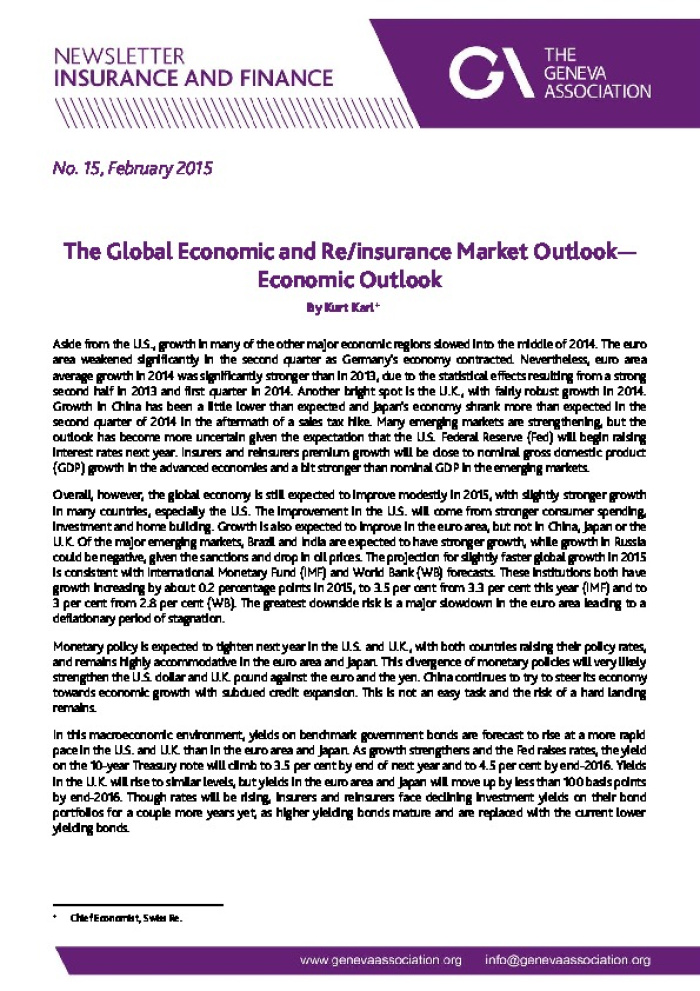The Global Economic and Re/insurance Market Outlook— Economic Outlook
Article from Insurance and Finance Newsletter No.15. K. Karl provides a Chief Economist’s perspective on the outlook for the global economy and the re/insurance market.

No. 15 , February 2015 The Global Economic and Re/insurance Market O utlook? Economic O utlook By Kurt Karl+ Aside from the U.S., growth in many of the other major economic regions slowed into the middle of 2014. The euro area weakened significantly in the second quarter as Germany's economy contracted. Nevertheless, euro area average growth in 2014 was significantl y stronger than in 2013, due to the statistical effects resulting from a strong second half in 2013 and first quarter in 2014. Another bright spot is the U.K. , with fairly robust growth in 2014. Growth in China has been a little lower than expec ted and Japan's economy shrank more than expected in the second quarter of 2014 in the aftermath of a sales tax hike. Many emerging markets are strengthening , but the outlook has become more uncertain given the expectation that the U.S. Federal Reserve (Fed) will begin raising interest rates next year. Insurers and reinsurers premium growth will be close to nominal gross domestic product (GDP) growth in the advanced economies and a bit stronger than nominal GDP in the emerging markets. Overall, however, the global economy is still expected to improve modestly in 2015 , with slightly stronger growth in many countries, especially the U.S. The improvement in the U.S. will come from stronger consumer spending, investment and home building . Growth is also expected to improve in the euro area, but not in China, Japan or the U.K. Of the major emerging markets, Brazil and India are expected to have stronger growth, while growth in Russia could be negative, given the sanctions and drop in oil prices. The projection for slightly faster global growth in 2015 is consistent with International Monetary Fund (IMF) and World Bank (WB) forecasts. These institutions both have growth increasing by about 0. 2 percentage points in 2015, to 3. 5 per cent from 3.3 per cent this year (IMF) and to 3 per cent from 2.8 per cent (WB). The greatest downside risk is a major slowdown in the euro area leading to a deflationary period of stagnation. Monetary policy is expected to tighten next year in the U.S. and U.K., with both countries raising their policy rates, and remains highly accommodative in the euro area and Japan. This divergence of monetary policies will very likely strengthen the U.S. dollar and U.K. pound against the euro and the yen. China continues to try to steer its economy toward s economic growth with subdued credit expansion. This is not an easy task and the risk of a hard landing remains. In this macroeconomic environment, yields on benchmark government bonds are forecast to rise at a more rapid pace in the U.S. and U.K. than in the euro area and Japan. As growth strengthens and the Fed raises rates, the yield on the 10 -year Treasury note will climb to 3.5 per cent by end of next year and to 4.5 per cent by end -2016. Yields in the U.K. will rise to similar levels, but yields in the euro area and Japan will move up by less than 100 basis points by end -2016. Though rates will be rising, insurers and reinsurers face declining investment yie lds on their bond portfolios for a couple more years yet, as higher yielding bonds mature and are replaced with the current lower yielding bonds. + Chief Economist, Swiss Re.